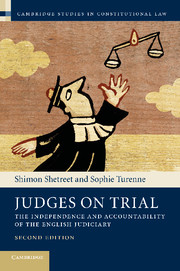Book contents
- Frontmatter
- Contents
- Foreword
- Acknowledgments
- Table of cases
- Table of legislation
- List of Abbreviations
- 1 Introduction
- 2 Constitutional steps towards judicial independence
- 3 The structure and governance of the English judiciary
- 4 Judicial appointments
- 5 Standards of conduct on the bench
- 6 Standards of conduct in extra-judicial activities
- 7 Immunity, discipline and removal of judges
- 8 Freedom of expression and public confidence in the judiciary
- 9 Conclusions
- Annex 1 Courts and tribunals structure
- Index
- References
4 - Judicial appointments
Published online by Cambridge University Press: 05 June 2014
- Frontmatter
- Contents
- Foreword
- Acknowledgments
- Table of cases
- Table of legislation
- List of Abbreviations
- 1 Introduction
- 2 Constitutional steps towards judicial independence
- 3 The structure and governance of the English judiciary
- 4 Judicial appointments
- 5 Standards of conduct on the bench
- 6 Standards of conduct in extra-judicial activities
- 7 Immunity, discipline and removal of judges
- 8 Freedom of expression and public confidence in the judiciary
- 9 Conclusions
- Annex 1 Courts and tribunals structure
- Index
- References
Summary
Introduction
4.1 In any system, the methods of appointment have direct bearing on both the integrity and independence of the judges. Weak appointments lower the status of the judiciary in the eyes of the public and create a climate in which the necessary independence of the judiciary is liable to be undermined. Similarly, political appointments that are seen by the public as not based on merit may arouse concern about the judge’s independence and impartiality on the bench. The quality of judicial appointments depends upon the process and standards applied by the appointing authorities, yet every appointment system has its limitations. It is difficult to predict what sort of judge a man or a woman will be and irreversible mistakes in judicial appointments are bound to occur, even when the method of appointment is fair and efficient and the standards are high, as they are in England. Such errors in selection apply equally to appointing persons who were unfit for occupying a judicial office as well as failing to appoint a person who might have been a good judge.
In this chapter, we consider the principles which shape the selection process and criteria. Professional competence and integrity are a universal requirement for appointment to the bench, and are encompassed in the English requirement of ‘merit and good character’. This requirement is underpinned, however, by the principles of transparency, independence from politics, a concern for a fair reflection of society in the appointment process and proper judicial accountability. Transparency, in particular, supports the prioritisation of merit and a fairer reflection of society. In England, the lack of diversity in the composition of the judiciary is noticeable at the level of the High Court and above, and the policies adopted to encourage diversity within the judiciary (from the ‘trickle up’ policy to the ‘need to have regard to diversity’) should not compromise the requirement of merit for judicial appointment. The Judicial Appointments Commission, which now recommends all appointments to the Lord Chancellor, can only have regard to the need to encourage diversity in the pool of applicants. This duty aims to address the persistent criticism of the judiciary that the judges have been white, male and upper middle class, privately educated Oxbridge graduates and barristers.
- Type
- Chapter
- Information
- Judges on TrialThe Independence and Accountability of the English Judiciary, pp. 102 - 178Publisher: Cambridge University PressPrint publication year: 2013



